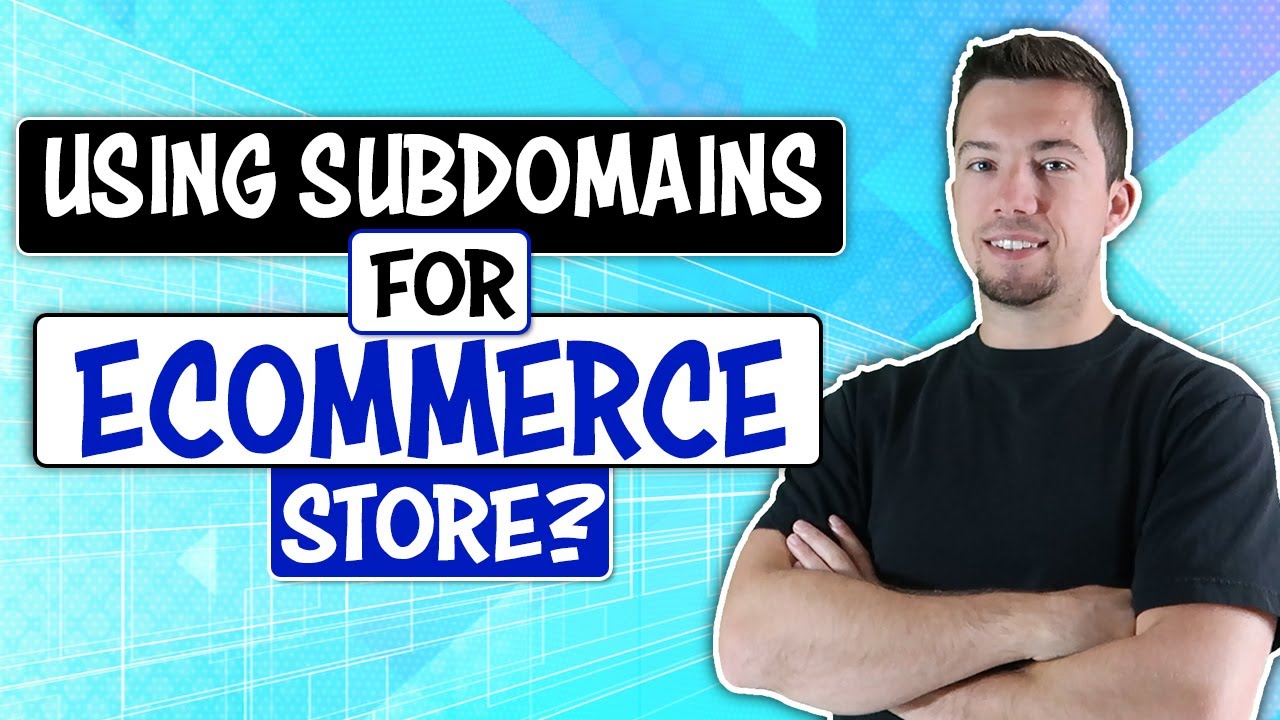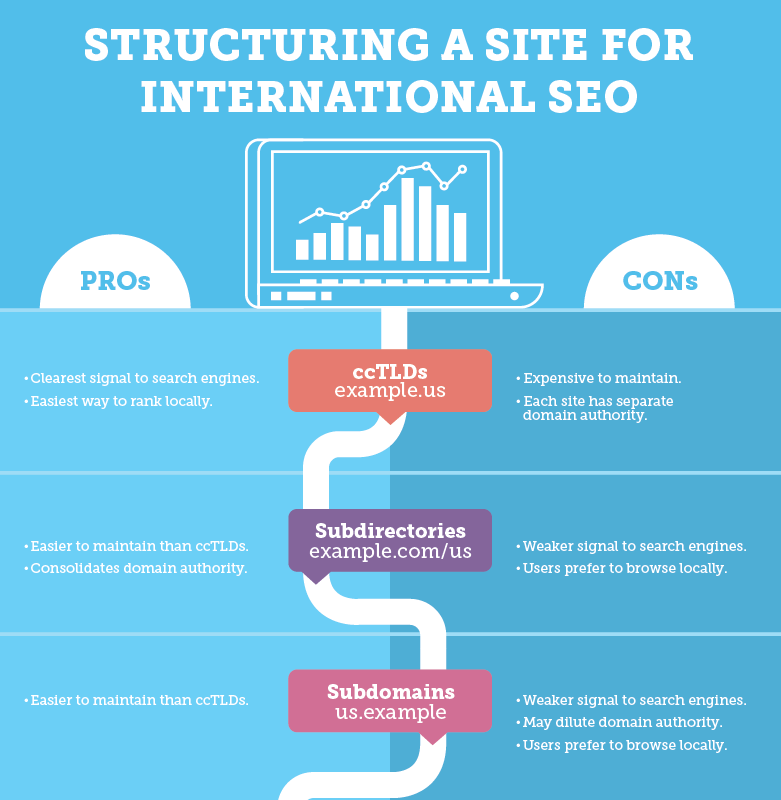Expanding your online presence internationally is an exciting prospect, but it also comes with important decisions to make regarding your domain structure.
Among subdomain subdirectory ccTLD which one should you use? Choosing between subdomains, subdirectories, or country code top-level domains (ccTLDs) can have a significant impact on your search traffic and international rankings.
Let's take a look at the pros and cons of each option and provide guidance on making the right choice for your business.
What Is A CCTLD?
A country code top-level domain (ccTLD) is a domain extension specific to a particular country. For example, ".co.uk" is the ccTLD for the United Kingdom. Registering a ccTLD signals your website's association with a specific country.
Pros Of CcTLDs
ccTLDs offer several advantages when it comes to international expansion. Let's take a look at some of the key benefits:
- Clearest signal to search engines -Using a ccTLD sends a strong signal to search engines about your website's country-specific targeting. When search engines see a ccTLD, they can quickly identify the geographical relevance of your website and potentially prioritize it in local search results.
- Quick and easy ranking -One of the significant advantages of ccTLDs is that they are typically the quickest and easiest way to rank your website in a new country or geographical area. Search engines often give preference to local ccTLDs, which can help you establish a strong online presence in your target market more efficiently.
- Different website experience -ccTLDs allow you to create unique website experiences tailored to different countries or target audiences. This means you can customize your content, language, currency, and even design elements to provide a more localized experience for your users. By delivering a personalized experience, you can enhance user engagement and increase conversion rates.
Cons Of CcTLDs
While ccTLDs offer several benefits, they also come with certain drawbacks that need to be considered:
- Expense and maintenance -Maintaining multiple websites with different ccTLDs can be expensive and time-consuming. Each ccTLD requires its own hosting, management, and maintenance, which can significantly increase costs. Additionally, managing multiple websites separately can be challenging, requiring dedicated resources and technical expertise.
- Separate domain authority-Each site with a ccTLD has its own domain authority and status. This means that the authority and ranking of one ccTLD do not directly transfer to others. Building and maintaining domain authority for each ccTLD separately can be a complex and resource-intensive task.

ccTLDs and online content explained
ccTLDs can have a strong impact on international rankings, providing clear signals to search engines and allowing for a tailored website experience in different countries. However, the expense and maintenance involved in managing multiple ccTLDs, along with the separate domain authority, make this approach a significant investment.
Therefore, if your international expansion plans involve targeting a large number of countries, ccTLDs may be the best option for you. However, if you are focusing on a limited number of countries, there are alternative options to consider.
What Is A Subdirectory?
A subdirectory is a division or alias of your primary domain that organizes your website into separate sections. For example, "example.com/us/" and "example.com/de/" are subdirectories targeting the United States and Germany, respectively.
Pros Of Subdirectories
Subdirectories offer several advantages when it comes to managing an international website. Let's explore some of the key benefits:
- Easier maintenance - Managing websites using subdirectories is simpler compared to ccTLDs and subdomains since content is typically managed within a single content management system(CMS). With a unified CMS, you can streamline content updates, design changes, and overall website maintenance.
- SEO-friendly structure -Reputable CMS platforms with multilingual options can set up a robust SEOstructure to cater to websites targeting different locations. Subdirectories allow you to maintain a consistent domain authority and link equity from your root domain, enhancing the overall SEOvalue of your website.
- Consolidated domain authority -Subdirectories consolidate domain authority from the root domain, which can positively impact overall SEO efforts. When you focus your efforts on a single domain, you can leverage the accumulated authority and rankings to boost your international subdirectories.
- Cost-effective -Subdirectories are generally the cheapest option to set up and maintain. Instead of purchasing and managing multiple ccTLDs, you can leverage your existing domain and infrastructure to create subdirectories at a lower cost.
Cons Of Subdirectories
While subdirectories offer several benefits, there are a few drawbacks to consider:
- Weaker signal to search engines -Subdirectories may provide a weaker signal to search engines compared to ccTLDs. Search engines may not immediately recognize the specific geographical targeting of subdirectories, which could impact their visibility in local search results.
- User preference for local domains - Some users may trust and prefer browsing websites using local domain names. If your target audience has a strong preference for local domains, subdirectories may not provide the same level of trust and credibility.
- Bloat and navigation complications -Subdirectories can potentially lead to bloated websites and complex navigation structures. As you expand your website with multiple subdirectories, it's essential to ensure proper organization and navigation to maintain a user-friendly experience.
Creating subdirectories is usually the easiest solution in terms of setup, long-term maintenance, and cost-effectiveness. Subdirectories allow you to maintain a unified domain authority, provide a centralized content management system, and carry over your existing rankings.
However, it's important to consider that subdirectories may provide a weaker signal to search engines and could be less preferred by users compared to local domains. Nevertheless, with proper optimization and strategic SEO efforts, subdirectories can be a successful approach for international expansion.

Should You Use Sub Domains or Sub Directories?
What Is A Subdomain?
A subdomain is a domain that is part of a primary domain address. For example, "uk.example.com" and "jp.example.com" are subdomains of the primary domain "example.com."
Pros Of Subdomains
Subdomains offer certain advantages when it comes to international website expansion. Let's explore some of the key benefits:
- Cost-effective and easier implementation -Subdomains are generally cheaper and require less effort to implement compared to ccTLDs. Instead of purchasing and managing multiple ccTLDs, you can create subdomains within your existing domain infrastructure at a lower cost.
- Different website experience - Similar to ccTLDs, subdomains allow you to create a different website experience for different countries or target audiences. You can customize content, language, design, and other elements specific to each subdomain, providing a more localized and personalized experience for users.
- Separate IP addresses or hosts -Subdomains can use separate IP addresses or hosts, enabling you to host your website in different locations. This can be beneficial if you want to provide a more localized hosting experience for specific countries or regions.
Cons Of Subdomains
While subdomains offer certain benefits, there are also drawbacks to consider:
- Weaker signal to search engines -Subdomains may provide a weaker signal to search engines compared to ccTLDs. Search engines may not immediately recognize the specific geographical targeting of subdomains, potentially impacting their visibility in local search results.
- User preference for local domains -Some users may trust and prefer browsing websites using local domain names. If your target audience has a strong preference for local domains, subdomains may not provide the same level of trust and credibility.
- Diluted domain authority -Each subdomain is treated as a separate website by search engines, which means that domain authority and rankings do not flow as seamlessly as with subdirectories. Building and maintaining authority for each subdomain individually can be challenging and require dedicated SEO efforts.
- Content management complexities -Content managed on different sub-sites can result in time-consuming updates and maintenance. Each subdomain needs to be managed separately, potentially adding complexity to content management processes.
Creating subdomains has its benefits in terms of cost-effectiveness and providing a different website experience for different countries or target audiences. However, it's important to consider the weaker signal to search engines, user preferences for local domains, and the potential dilution of domain authority.

Should You Use Subdomains for Your eCommerce Store? (Pros & Cons)
Subdomains are typically not the preferred option for international SEO, as they require a larger SEO investment to build rankings and authority for each subdomain. Nevertheless, they can be suitable in specific cases where hosting in separate locations is necessary.
Subdomain, Subdirectory, CCTLD, Which One Should You Use?
Choosing the right domain structure for international expansion requires careful consideration.
Here are some key factors to consider when making your decision:
- Target countries -If you have specific countries in mind for expansion, registering the relevant ccTLDs for those countries can be a safe and effective option. This is particularly relevant if legal requirements or local preferences necessitate a local domain presence.
- Budget -Implementing and maintaining ccTLDs can be costly, as it involves purchasing multiple domains and managing separate websites. If budget is a constraint, subdirectories within your existing domain may be a more cost-effective solution.
- Technical feasibility -Consider the technical capabilities and limitations of your website infrastructure. Some CMS platforms may offer better support for subdirectories, while others may have limitations in managing subdomains or ccTLDs. Choose an option that aligns with your technical capabilities and resources.
- SEO considerations -Evaluate the impact on SEO when choosing between subdomains, subdirectories, or ccTLDs. While ccTLDs provide a clear signal to search engines, subdirectories can leverage the existing domain authority and subdomains offer a more cost-effective approach. Consider your SEO goals, resources, and the competitive landscape in your target markets.
- User preferences - Understand your target audience and their preferences. Some users may trust and prefer browsing websites with local domain names, while others may not have a strong preference. Consider user trust, credibility, and the impact on user experiencewhen making your decision.
By carefully considering these factors, you can make an informed choice between subdomains, subdirectories, or ccTLDs that aligns with your businessgoals, budget, technical capabilities, and target audience preferences.
Key Considerations
Let's take a quick look at the key considerations for ccTLDs, subdirectories, and subdomains, to help you make an informed decision:
- ccTLDs provide a clear signal to search engines, quick ranking opportunities, and the ability to create a unique website experience for different countries. However, they can be expensive and require separate maintenance and management.
- Subdirectories offer easier maintenance, SEO-friendly structure, consolidated domain authority, and cost-effectiveness. They may have a weaker signal to search engines and could be less preferred by users compared to local domains.
- Subdomainsare cost-effective, allow for different website experiences, and can use separate IP addresses or hosts. However, they may provide a weaker signal to search engines, user preferences for local domains, and content management complexities.
People Also Ask
What Is The Difference Between CcTLD And Subdomain?
ccTLDs are country-specific top-level domains that indicate a website's association with a particular country. On the other hand, subdomains allow you to focus on specific languages or unique content within your website. While ccTLDs target countries, subdomains provide flexibility for language or content variations.
What Is The Most Used CcTLD?
Popular ccTLD Domain Extensions:
| .cn | With 24.7 million registered domains, it represents China. |
| .de | Germany's ccTLD, boasting 16.6 million registered domains. |
| .uk | The United Kingdom's ccTLD with 10.8 million registered domains. |
| .nl | The Netherlands' ccTLD, known for its 6.0 million registered domains. |
Are Subdomains Always Safe?
The safety of a domain, including subdomains, relies on how its owner manages it. Whether it's a subdomain (www.) or a subpath (/a/subfoldername), they are not inherently safer or different from the main domain. The owner retains control over them unless they grant control to others.
Conclusion
Among subdomain subdirectory ccTLD which one should you use? When expanding your online presence internationally, choosing the right domain structure is crucial for success. While each option—ccTLDs, subdomains, and subdirectories—comes with its own pros and cons, it's important to select the approach that best aligns with your specific requirements and resources.
Ultimately, the choice between ccTLDs, subdomains, and subdirectories depends on your specific goals, budget, technical capabilities, and user preferences. Carefully consider these factors and choose the option that best suits your international expansion strategy.

